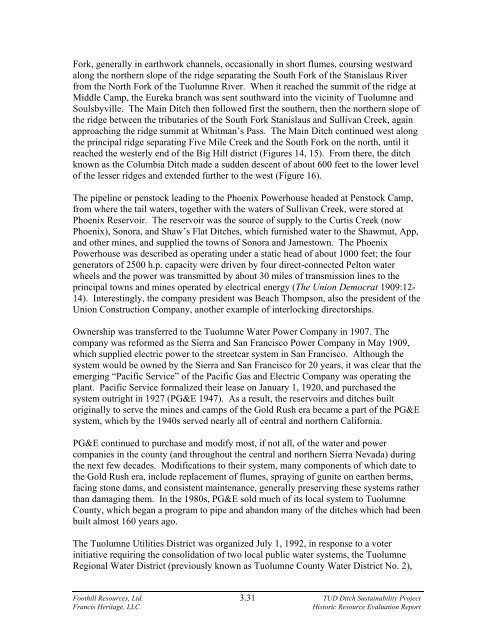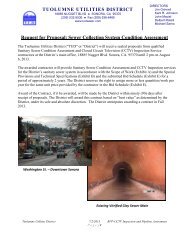Historic Resource Evaluation Project - Tuolumne Utilities District
Historic Resource Evaluation Project - Tuolumne Utilities District
Historic Resource Evaluation Project - Tuolumne Utilities District
You also want an ePaper? Increase the reach of your titles
YUMPU automatically turns print PDFs into web optimized ePapers that Google loves.
Fork, generally in earthwork channels, occasionally in short flumes, coursing westward<br />
along the northern slope of the ridge separating the South Fork of the Stanislaus River<br />
from the North Fork of the <strong>Tuolumne</strong> River. When it reached the summit of the ridge at<br />
Middle Camp, the Eureka branch was sent southward into the vicinity of <strong>Tuolumne</strong> and<br />
Soulsbyville. The Main Ditch then followed first the southern, then the northern slope of<br />
the ridge between the tributaries of the South Fork Stanislaus and Sullivan Creek, again<br />
approaching the ridge summit at Whitman’s Pass. The Main Ditch continued west along<br />
the principal ridge separating Five Mile Creek and the South Fork on the north, until it<br />
reached the westerly end of the Big Hill district (Figures 14, 15). From there, the ditch<br />
known as the Columbia Ditch made a sudden descent of about 600 feet to the lower level<br />
of the lesser ridges and extended further to the west (Figure 16).<br />
The pipeline or penstock leading to the Phoenix Powerhouse headed at Penstock Camp,<br />
from where the tail waters, together with the waters of Sullivan Creek, were stored at<br />
Phoenix Reservoir. The reservoir was the source of supply to the Curtis Creek (now<br />
Phoenix), Sonora, and Shaw’s Flat Ditches, which furnished water to the Shawmut, App,<br />
and other mines, and supplied the towns of Sonora and Jamestown. The Phoenix<br />
Powerhouse was described as operating under a static head of about 1000 feet; the four<br />
generators of 2500 h.p. capacity were driven by four direct-connected Pelton water<br />
wheels and the power was transmitted by about 30 miles of transmission lines to the<br />
principal towns and mines operated by electrical energy (The Union Democrat 1909:12-<br />
14). Interestingly, the company president was Beach Thompson, also the president of the<br />
Union Construction Company, another example of interlocking directorships.<br />
Ownership was transferred to the <strong>Tuolumne</strong> Water Power Company in 1907. The<br />
company was reformed as the Sierra and San Francisco Power Company in May 1909,<br />
which supplied electric power to the streetcar system in San Francisco. Although the<br />
system would be owned by the Sierra and San Francisco for 20 years, it was clear that the<br />
emerging “Pacific Service” of the Pacific Gas and Electric Company was operating the<br />
plant. Pacific Service formalized their lease on January 1, 1920, and purchased the<br />
system outright in 1927 (PG&E 1947). As a result, the reservoirs and ditches built<br />
originally to serve the mines and camps of the Gold Rush era became a part of the PG&E<br />
system, which by the 1940s served nearly all of central and northern California.<br />
PG&E continued to purchase and modify most, if not all, of the water and power<br />
companies in the county (and throughout the central and northern Sierra Nevada) during<br />
the next few decades. Modifications to their system, many components of which date to<br />
the Gold Rush era, include replacement of flumes, spraying of gunite on earthen berms,<br />
facing stone dams, and consistent maintenance, generally preserving these systems rather<br />
than damaging them. In the 1980s, PG&E sold much of its local system to <strong>Tuolumne</strong><br />
County, which began a program to pipe and abandon many of the ditches which had been<br />
built almost 160 years ago.<br />
The <strong>Tuolumne</strong> <strong>Utilities</strong> <strong>District</strong> was organized July 1, 1992, in response to a voter<br />
initiative requiring the consolidation of two local public water systems, the <strong>Tuolumne</strong><br />
Regional Water <strong>District</strong> (previously known as <strong>Tuolumne</strong> County Water <strong>District</strong> No. 2),<br />
Foothill <strong>Resource</strong>s, Ltd. 3.31 TUD Ditch Sustainability <strong>Project</strong><br />
Francis Heritage, LLC<br />
<strong>Historic</strong> <strong>Resource</strong> <strong>Evaluation</strong> Report




